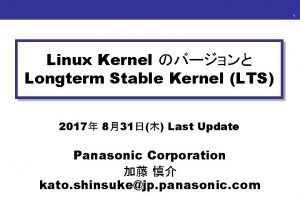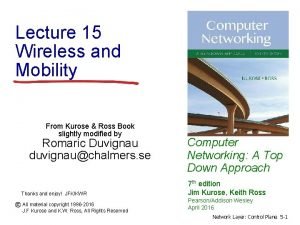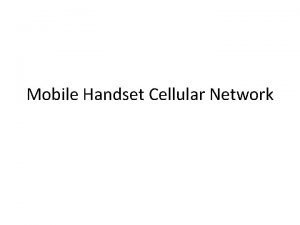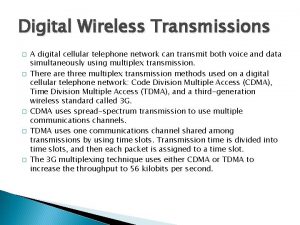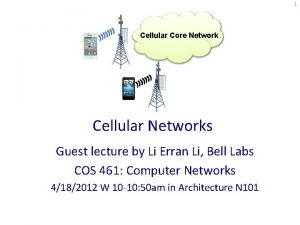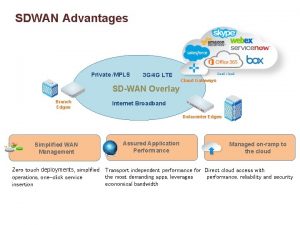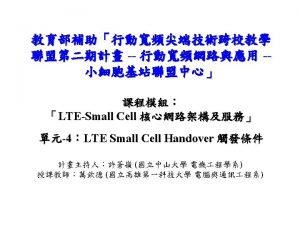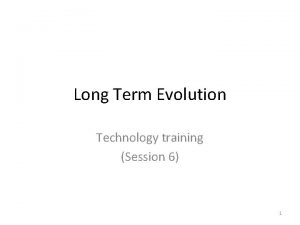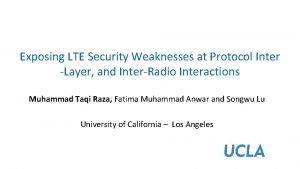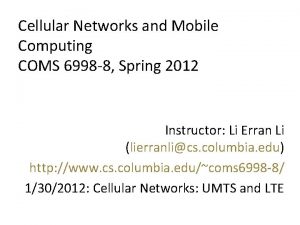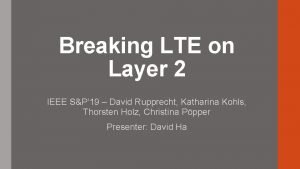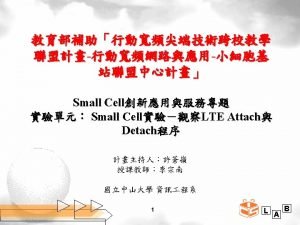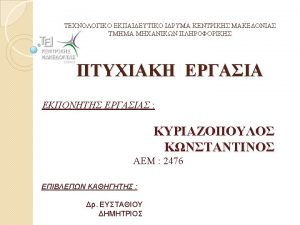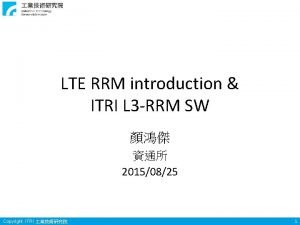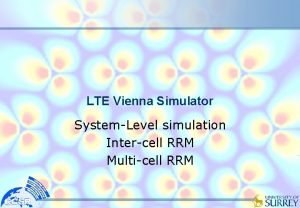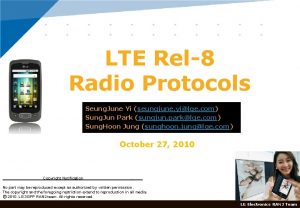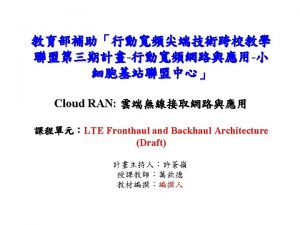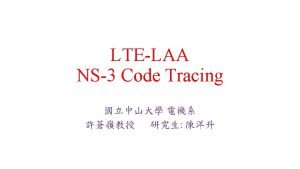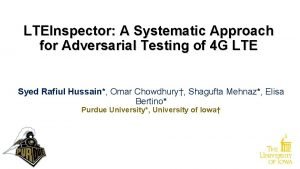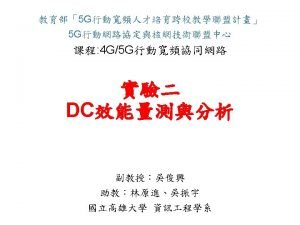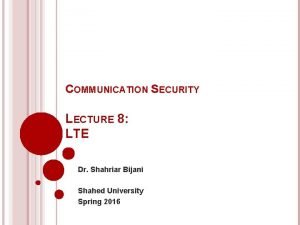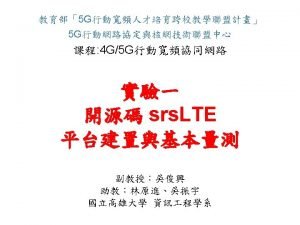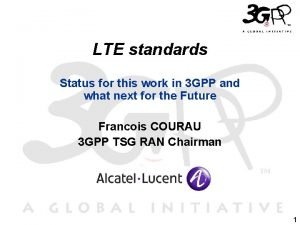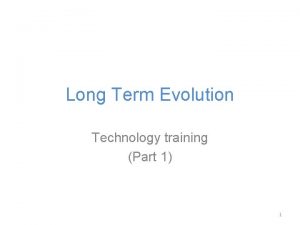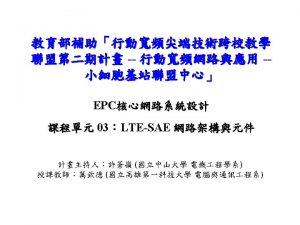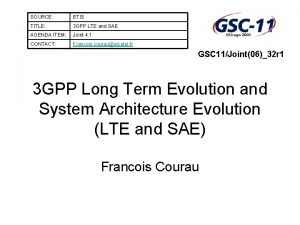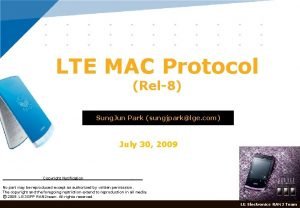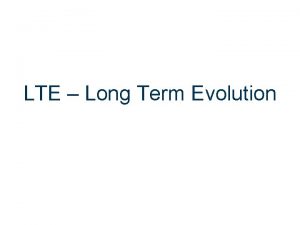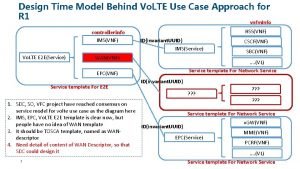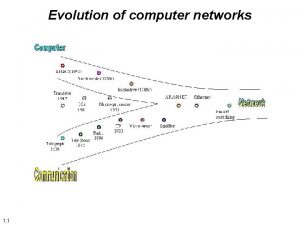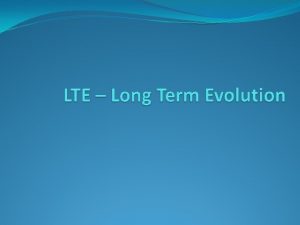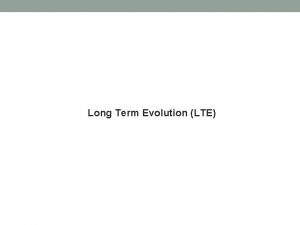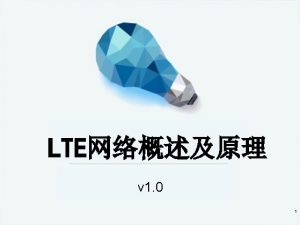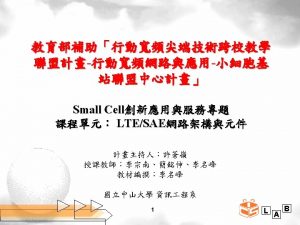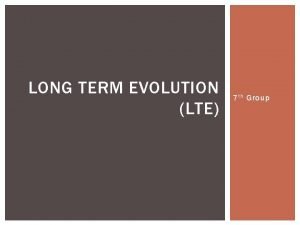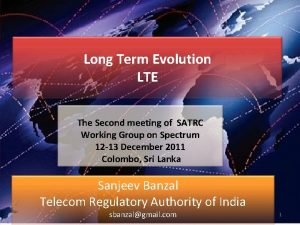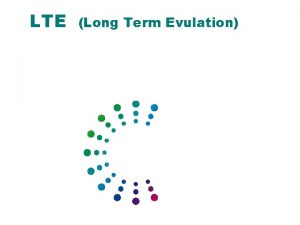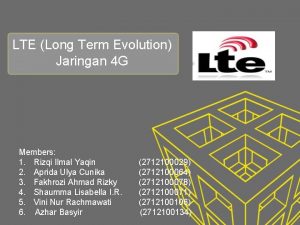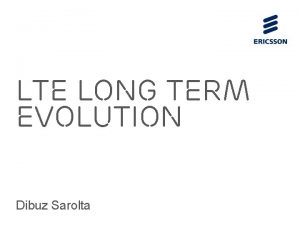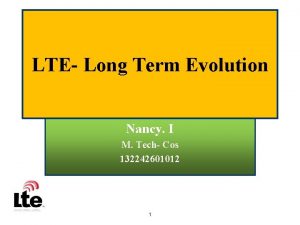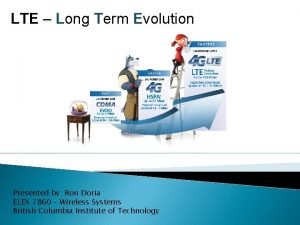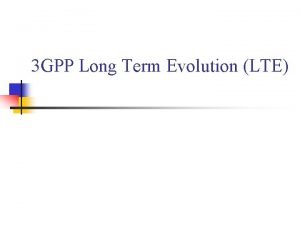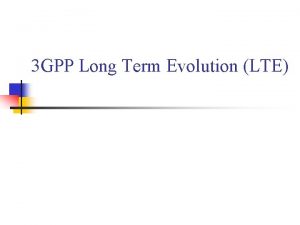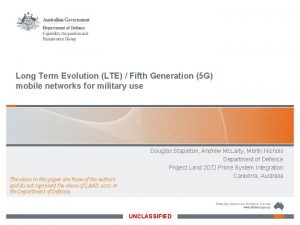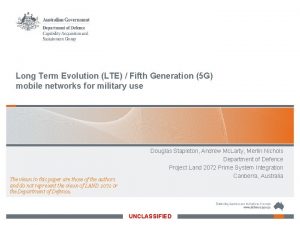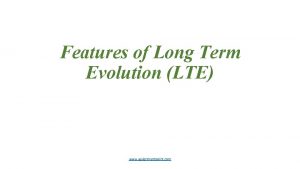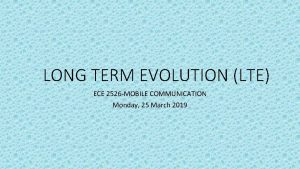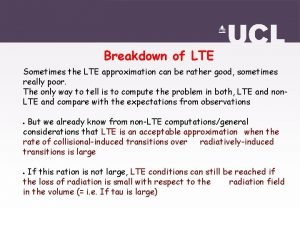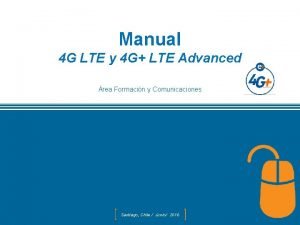Cellular Network 2 Long Term Evolution LTE LongTerm













































- Slides: 45

Cellular Network

2 Long Term Evolution (LTE) • Long-Term Evolution (LTE) is a standard for high- speed wireless communication for mobile devices and data terminals, based on the GSM/EDGE and UMTS/HSPA (High Speed Packet Access) technologies. • GSM (Global System for Mobile communication) • EDGE (Enhanced Data rates for GSM Evolution) • UMTS (Universal Mobile Telecommunications Service) • HSPA (High Speed Packet Access) • WCDMA (Wideband CDMA) • GPRS (General Packet Radio Services) • HSCSD (High-Speed Circuit-Switched Data)

Cellular Network Basics • There are many types of cellular services; before delving into details, focus on basics (helps navigate the “acronym soup”) • Cellular network/telephony is a radio-based technology; radio waves are electromagnetic waves that antennas propagate • Most signals are in the 850 MHz, 900 MHz, 1800 MHz, and 1900 MHz frequency bands Cell phones operate in this frequency range (note the logarithmic scale)

Cellular Network • Base stations transmit to and receive from mobiles at the assigned spectrum – Multiple base stations use the same spectrum (spectral reuse) • The service area of each base station is called a cell • Each mobile terminal is typically served by the ‘closest’ base stations – Handoff when terminals move

5 Cellular Network Generations: Ø 1 G: ü Analog cellular telephony. Ø 2 G: ü Digital cellular telephony. Ø 3 G: ü High-speed digital cellular telephony (including video telephony). Ø 4 G: ü IP-based voice, data, and multimedia telephony (at faster data rates than 3 G).

6 The Source of “G”:

7 Evolution of Mobile Communications: From 1 G to 4 G

The Multiple Access Problem • The base stations need to serve many mobile terminals at the same time (both downlink and uplink) • All mobiles in the cell need to transmit to the base station • Interference among different senders and receivers • So we need multiple access scheme

9 The Multiple Access Problem: Ø FDMA: Ø TDMA: Data Signal Ø CDMA: PN Sequence Tx Signal

2 G(GSM)

GSM • Abbreviation for Global System for Mobile Communications • Concurrent development in USA and Europe in the 1980’s • The European system was called GSM and deployed in the early 1990’s

GSM Services • Voice, 3. 1 k. Hz • Short Message Service (SMS) • 1985 GSM standard that allows messages of at most 160 chars. (incl. spaces) to be sent between handsets and other stations • Over 2. 4 billion people use it; multi-billion $ industry • General Packet Radio Service (GPRS) • GSM upgrade that provides IP-based packet data transmission up to 114 kbps • Users can “simultaneously” make calls and send data • GPRS provides “always on” Internet access and the Multimedia Messaging Service (MMS) whereby users can send rich text, audio, video messages to each other • Performance degrades as number of users increase • GPRS is an example of 2. 5 G telephony – 2 G service similar to 3 G

GSM Channels Downlink Channels Uplink • Physical Channel: Each timeslot on a carrier is referred to as a physical channel • Logical Channel: Variety of information is transmitted between the MS and BTS. Different types of logical channels: • Traffic channel • Control Channel

GSM Frequencies • Originally designed on 900 MHz range, now also available on 800 MHz, 1800 MHz and 1900 MHz ranges. • Separate Uplink and Downlink frequencies • One example channel on the 1800 MHz frequency band, where RF carriers are space every 200 MHz UPLINK FREQUENCIES 1710 MHz DOWNLINK FREQUENCIES 1785 MHz 1805 MHz UPLINK AND DOWNLINK FREQUENCY SEPARATED BY 95 MHZ 1880 MHz

GSM Architecture

Mobile Station (MS) • MS is the user’s handset and has two parts • Mobile Equipment • Radio equipment • User interface • Processing capability and memory required for various tasks • Call signalling • Encryption • SMS • Equipment IMEI number • Subscriber Identity Module

Subscriber Identity Module • A small smart card • Encryption codes needed to identify the subscriber • Subscriber IMSI number • Subscriber’s own information (telephone directory) • Third party applications (banking etc. ) • Can also be used in other systems besides GSM, e. g. , some WLAN access points accept SIM based user authentication

Base Station Subsystem • Transcoding Rate and Adaptation Unit (TRAU) • Performs coding between the 64 kbps PCM coding used in the backbone network and the 13 kbps coding used for the Mobile Station (MS) • Base Station Controller (BSC) • Controls the channel (time slot) allocation implemented by the BTSes • Manages the handovers within BSS area • Knows which mobile stations are within the cell and informs the MSC/VLR about this • Base Transceiver System (BTS) • Controls several transmitters • Each transmitter has 8 time slots, some used for signaling, on a specific frequency

Network and Switching Subsystem • The backbone of a GSM network is a telephone network with additional cellular network capabilities • Mobile Switching Center (MSC) • An typical telephony exchange (ISDN exchange) which supports mobile communications • Visitor Location Register (VLR) • A database, part of the MSC • Contains the location of the active Mobile Stations • Gateway Mobile Switching Center (GMSC) • Links the system to PSTN and other operators • Home Location Register (HLR) • Contain subscriber information, including authentication information in Authentication Center (Au. C) • Equipment Identity Register (EIR) • International Mobile Station Equipment Identity (IMEI) codes for e. g. , blacklisting stolen phones

Home Location Register • One database per operator • Contains all the permanent subscriber information • MSISDN (Mobile Subscriber ISDN number) is the telephone number of the subscriber • International Mobile Subscriber Identity (IMSI) is a 15 digit code used to identify the subscriber • It incorporates a country code and operator code • IMSI code is used to link the MSISDN number to the subscriber’s SIM (Subscriber Identity Module) • Charging information • Services available to the customer • Also the subscriber’s present Location Area Code, which refers to the MSC, which can connect to the MS.

Other Systems • Operations Support System • The management network for the whole GSM network • Usually vendor dependent • Very loosely specified in the GSM standards • Value added services • Voice mail • Call forwarding • Group calls • Short Message Service Center • Stores and forwards the SMS messages • Like an E-mail server • Required to operate the SMS services

Location Updates • The cells overlap and usually a mobile station can ‘see’ several transceivers (BTSes) • The MS monitors the identifier for the BSC controlling the cells • When the mobile station reaches a new BSC’s area, it requests an location update • The update is forwarded to the MSC, entered into the VLR, the old BSC is notified an acknowledgement is passed back

Handoff (Handover) • When a call is in process, the changes in location need special processing • Within a BSS, the BSC, which knows the current radio link configuration (including feedbacks from the MS), prepares an available channel in the new BTS • The MS is told to switch over to the new BTS • This is called a hard handoff • In a soft handoff, the MS is connected to two BTSes simultaneously

Roaming • When a MS enters another operators network, it can be allowed to use the services of this operator • Operator to operator agreements and contracts • Higher billing • The MS is identified by the information in the SIM card and the identification request is forwarded to the home operator • The home HLR is updated to reflect the MS’s current location

3 G, 3. 5 G AND 4 G (LTE)

3 G Overview • 3 G is created by ITU-T and is called IMT-2000

27 Evolution of Mobile Communications: From 2 G to 3 G

GSM Evolution: From 2 G to 3 G Dedicate up to 4 timeslots for data connection ~ 50 kbps Good for real-time applications (but inefficient) HSCSD GSM 9. 6 kbps (one timeslot) GSM GPRS Enhanced Data Rates for Global Evolution 3 x improvement in data rate ~ 384 kbps Can fall back to GMSK for greater distances General Packet Radio Services Data rates up to ~ 115 kbps Max: 8 timeslots used as any one time Packet switched (Efficient, but variable delays) 28 WCDMA EDGE

29 Evolution of Mobile Communications: From 1 G to 4 G

UMTS • Universal Mobile Telecommunications System (UMTS) • UMTS is an upgrade from GSM via GPRS or EDGE • The standardization work for UMTS is carried out by Third Generation Partnership Project (3 GPP) • Data rates of UMTS are: – 144 kbps for rural – 384 kbps for urban outdoor – 2048 kbps for indoor and low range outdoor • Virtual Home Environment (VHE)

UMTS Frequency Spectrum • UMTS Band • 1900 -2025 MHz and 2110 -2200 MHz for 3 G transmission • In the US, 1710– 1755 MHz and 2110– 2155 MHz will be used instead, as the 1900 MHz band was already used.

UMTS Network Architecture • UMTS network architecture consists of three domains – Core Network (CN): Provide switching, routing and transit for user traffic – UMTS Terrestrial Radio Access Network (UTRAN): Provides the air interface access method for user equipment. – User Equipment (UE): Terminals work as air interface counterpart for base stations. The various identities are: IMSI, TMSI, P-TMSI, TLLI, MSISDN, IMEISV

4 G (LTE) • LTE stands for Long Term Evolution • Next Generation mobile broadband technology • Promises data transfer rates of 100 Mbps • Based on UMTS 3 G technology • Optimized for All-IP traffic

34 Outlines: Ø Motivation Ø LTE Performance Requirements Ø Key Features of LTE Ø OFDM & SC-FDMA Ø LTE Network Architecture Ø Multiple Antenna Techniques Ø LTE-A Specifications Ø Summary

35 Motivation: ØNeed for higher data rates and greater spectral efficiency: Ø Can be achieved with HSDPA/HSUPA ((High Speed Packet Access) Ø and/or new air interface defined by 3 GPP (3 rd Generation Partnership Project) LTE ØNeed for Packet Switched optimized system: Ø Evolve UMTS towards packet only system ØNeed for high quality of services: Ø Use of licensed frequencies to guarantee quality of services Ø Reduce control plane latency & round trip delay ØNeed for cheaper infrastructure: Ø Simplify architecture (reduce number of network elements)

36 LTE Performance Requirements: ØData Rate: Ø Downlink peak data rate of 100 Mbit/s in a 20 MHz downlink spectrum. Ø Uplink peak data rate of 50 Mbit/s in a 20 MHz uplink spectrum. ØMobility: Ø Optimized for low mobility (0 -15 km/h) but supports high speed. ØLatency: Ø user plane < 5 ms Ø control plane < 50 ms Ø The control plane is the part of a network that carries signaling traffic and is responsible for routing.

37 LTE Performance Requirements: ØImproved spectrum efficiency. ØImproved broadcasting. ØIP-optimized. ØScalable bandwidth: Ø 20 MHz, 15 MHz, 10 MHz, 5 MHz and <5 MHz ØCo-existence with legacy standards: Ø Users can transparently start a call or transfer of data in an area using an LTE standard, and when there is no coverage, continue the operation using GSM/GPRS or W-CDMA-based UMTS.

38 LTE Key Features: ØMultiple access scheme: Ø Downlink: OFDMA (Orthogonal frequency-division multiple access) Ø Uplink: SC-FDMA (Single-carrier FDMA) Ø Adaptive modulation: Ø DL modulations: QPSK, 16 QAM, and 64 QAM Ø UL modulations: QPSK and 16 QAM ØBandwidth scalability: Ø For efficient operation in differently sized allocated spectrum bands. ØMultiple Antenna (MIMO) technology: Ø For enhanced data rate and performance. ØPower control and link adaptation. ØImplicit support for interference coordination.

Comparison of LTE Speed

40 Adaptive Modulation:

41 LTE-A Network Architecture: e. NBs (evolved Node. Bs) as base stations Evolved Packet Core (EPC) Policy and Charging Rules Function (PCRF) Mobility Management Entity (MME) The MME is a control entity. Packet Data Network (PDN) Serving Gateway (SGW) SGW terminates the interface towards EUTRAN E-UTRA is the air interface of 3 rd Generation Partnership Project (3 GPP) Long Term Evolution (LTE) . PDN Gateway (PGW) Home Subscriber Server (HSS) The HSS is a central database.

42 MIMO:

43 Comparison of 3 G & LTE-A Specifications:

44 LTE-A Specifications:

45 Summary: ØLTE-A is a highly optimized, spectrally efficient, mobile OFDMA solution built from the ground up for mobility. ØIt allows operators to offer advanced services and higher performance for new and wider bandwidths. ØIt is based on a flattened IP-based network architecture that improves network latency. ØIt is compatible with existing 3 GPP networks. ØIt leverages the benefits of existing 3 G technologies and enhances them further with additional antenna techniques (such as higher-order MIMO).
 Kernel longterm
Kernel longterm Thomas silverstein art
Thomas silverstein art Lte network architecture
Lte network architecture Long term evolution - advanced
Long term evolution - advanced Short term planning and long term planning
Short term planning and long term planning Long term memory vs short term memory
Long term memory vs short term memory Short term human resource planning
Short term human resource planning Difference between long term and short term liabilities
Difference between long term and short term liabilities Accounting for serial bonds
Accounting for serial bonds Long term goals
Long term goals Short term and long term cash forecasting
Short term and long term cash forecasting Tall+short h
Tall+short h Once upon a time there lived an old man
Once upon a time there lived an old man Nucleoplasm
Nucleoplasm Cellular network range
Cellular network range A satellite used in a cellular telephone network
A satellite used in a cellular telephone network Cellular core network
Cellular core network Mpls over lte
Mpls over lte Mobility mode
Mobility mode Transmit diversity in lte
Transmit diversity in lte Paging in lte
Paging in lte Frame structure in lte
Frame structure in lte Lte layer 2
Lte layer 2 Lte attach procedure
Lte attach procedure Lte τεστ προσομοιωσης
Lte τεστ προσομοιωσης V0 lte
V0 lte L
L Tactical lte
Tactical lte Congress of vienna simulation
Congress of vienna simulation Lte nas procedures
Lte nas procedures Fronthaul and backhaul transport
Fronthaul and backhaul transport Ns3 tutorialspoint
Ns3 tutorialspoint Lteinspector
Lteinspector V lte symbol on phone
V lte symbol on phone Gpp lte means
Gpp lte means 16 0
16 0 Gpp lte meaning
Gpp lte meaning Physical layer in lte
Physical layer in lte V0 lte
V0 lte V0 lte
V0 lte Sae epc
Sae epc Gpp lte
Gpp lte Sung jun park
Sung jun park Dtch lte
Dtch lte V0 lte
V0 lte Computer networking
Computer networking
